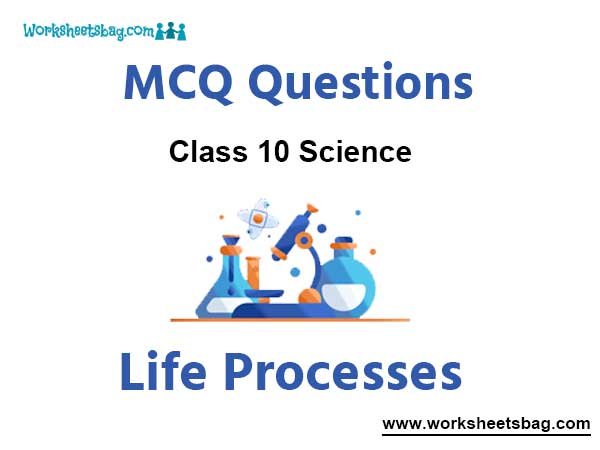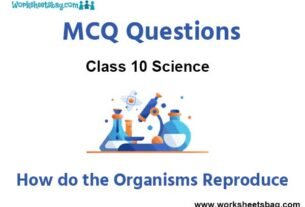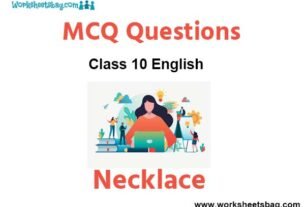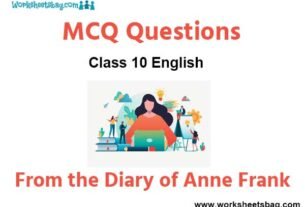Please refer to Life Processes MCQ Questions Class 10 Science below. These MCQ questions for Class 10 Science with answers have been designed as per the latest NCERT, CBSE books, and syllabus issued for the current academic year. These objective questions for Life Processes will help you to prepare for the exams and get more marks.
Life Processes MCQ Questions Class 10 Science
Please see solved MCQ Questions for Life Processes in Class 10 Science. All questions and answers have been prepared by expert faculty of standard 10 based on the latest examination guidelines.
MCQ Questions Class 10 Science Life Processes
Question: Energy rich foods are
a) Carbohydrates and fats
b) Proteins and mineral salts
c) Vitamins and minerals
d) Water and roughage
Answer:
A
Question: Life process that converts chemical energy into heat energy
a) Nutrition
b) Respiration
c) Digestion
d) Excretion
Answer:
B
Question: Pick out the incorrect statement
a) Organisms grow with time
b) Organisms must repair and maintain their structure
c) Movement of molecules does not take place among cells
d) Energy is essential for life processes
Answer:
C
Question: Transpiration occurs from
a) Stomata
b) Cuticle
c) Both of these
d) None of these
Answer:
C
Question: The process in which loss of water takes place in the form of water vapour through stomata is called
a) Transportation
b) Transpiration
c) Guttation
d) Translocation
Answer:
B
Question: The plant part that do not involve in exchange of gas is
a) Leaf
b) Flower
c) Root
d) Stem
Answer:
B
Question: Loss of water from leaves will be less if stomata are
a) Only on lower surface
b) Only on upper surface
c) On both the surfaces
d) Scattered
Answer:
A
Question: Among the following group of plants, select the plant where you find stomata open at night and
close by day time
a) Epiphytes
b) Succulents
c) Mangroves
d) Hydrophytes
Answer:
B
Question: The mounting material used in the preparation of a leaf peel is
a) Water
b) Glycerine
c) Wax
d) None of these
Answer:
B
Question: The transport of water to upper parts of the plants during night is due to
a) Root pressure
b) Transpiration
c) Translocation
d) Leaf pressure
Answer:
A
Question: The principal transpiring organ of a plant is
a) Root
b) Stem
c) Flower
d) Leaf
Answer:
B
Question: Transpiration helps in
a) Temperature regulation
b) Maintaining upward movement of water
c) Wilting of leaves
d) Both a and b
Answer:
D
Question: The stain that is generally used in preparing a temporary mount of a leaf put to show stomata is
a) Safranin
b) Hematoxylin
c) Acetocarmine
d) Eosin
Answer:
A
Question: The type of leaf to be selected while preparing a temporary mount of a leaf peel to show stomata is
a) Turgid
b) Flaccid
c) Turbid
d) Flattened
Answer:
A
Question: The force of water absorption affected by opening and closing of stomata is
a) Root pressure
b) Transpiration pull
c) Both of these
d) None of these
Answer:
B
Question: Opening of stomata is influenced more by
a) Red light
b) Green light
c) Indigo light
d) Blue light
Answer:
D
Question: Guard cells differ from epidermal cells in having
a) Vacuoles
b) Nucleus
c) Mitochondria
d) Chloroplasts
Answer:
D
Question: Plant groups in which sunken stomata are generally found are
a) Mesophytes
b) Epiphytes
c) Xerophytes
d) Hydrophytes
Answer:
C
Question: The part of leaf commonly used for preparing the slide of stomata is
a) Leaf margin
b) Leaf apex
c) Leaf epidermis
d) Leaf petiole
Answer:
C
Question: Woody plants carry gaseous exchange through
a) Root hair
b) Stem hair
c) Lenticels
d) Epidermal cells
Answer:
C
Question: Xerophytes have drought tolerance as compared to mesophytes because of
a) Thick cuticle
b) Sunken stomata
c) Very less transpiration
d) d) All of these
Answer:
D
Question: Roots of the plants absorb water from the soil through the process of
a) Diffusion
b) Transpiration
c) Osmosis
d) None of these
Answer:
C
Question. Animals having two respiratory pigments :-
a) Serpula
b) Glycera
c) Nereis
d) All of above
Answer:
A
Question. Find out the correct sequence of enzymes, substrate and end product
a) peptidases-proteins-amino acids
b) peptidases-peptides-amino acids
c) trypsin-fats-amino acids
d) maltase-maltose-glucose & galactose
Answer:
B
Question. Heart with single circulation is found in :-
a) Mammals and birds
b) Reptiles
c) Fishes and amphibians
d) Fishes only
Answer:
D
Question. A bolus is
a) a mass of crushed food moistened with saliva
b) the semisolid material resulting from. partial digestion in the stomach
c) the milky emulsified fat absorbed from small intestine
d) indigestible materials that helps in movement and absorption
Answer:
A
Question. Cardiac cycle in man takes about :-
a) 0.5 seconds
b) 1.0 seconds
c) 1.2 seconds
d) 0.8 seconds
Answer:
D
Question. Where are red blood cells formed ?
a) Spleen
b) Liver
c) Red bone marrow of long bones
d) Thyroid
Answer:
C
Question. Saliva has the enzyme
a) pepsin
b) ptyalin
c) trypsin
d) rennin
Answer:
B
Question. Goitre is caused due to deficiency of :-
a) Calcium
b) Iodine
c) Fluorine
d) Phosphorus
Answer:
B
Question. Inactive enzyme precursors, such as pepsinogen for pepsin, are called
a) holoenzymes
b) actinases
c) zymogens
d) mucopolysaccharides
Answer:
C
Question. Gastric digestion takes place efficiently in
a) acidic medium
b) alkaline medium
c) neutral medium
d) highly alkaline medium
Answer:
A
Question. Diastema is associated with
a) presence of certain teeth
b) absence of certain teeth
c) absence of tongue
d) presence of tongue
Answer:
B
Question. Chief function of bile is
a) to digest fat by enzymatic action
b) to emulsify fat for digestion
c) to eliminate waste product
d) to regulate ‘process of digestion
Answer:
B
Question. Deficiency of protein in a child, in the age group of 1 to 3 years, causes :-
a) Marasmus
b) Dwarfism
c) Gigantism
d) Kwashiorkor
Answer:
D
Question. Educated people are becoming more and more conscious about their high blood pressure ; one of the reasons is that :-
a) one becomes over active
b) one’s urine excretion increases
c) one’s cardiac output increases
d) ultra filteration under abnormal high blood pressure may rupture capillary walls of the glomeruli, leading to kidney failure
Answer:
D
Question. Paneth’s cells are found in
a) Crypts of Lieberkuhn
b) Peyer’s patches
c) Organ of Corti
d) Islets of Langerhans
Answer:
A
Question. Ileum is
a) first part of the small intestine
b) middle part of the small intestine
c) last part of the small intestine
d) not a part of the small intestine
Answer:
C
Question. The blood pressure is measured by :-
a) Electrocardiogram (ECG)
b) Stethoscope
c) Sphygmomanometer
d) Pulse rate
Answer:
C
Question. Which one of the following is the matching set of the gland and its secretion?
a) Pituitary gland-thyroxin
b) Salivary gland-amylase
c) Adrenal cortex-vasopressin
d) Islets of Langerhans-secretin
Answer:
B
Question. In a villus, some of the glycerol and fatty acids are combined to form fats, coated with proteins, and then transported as chylomicrons to the
a) lacteal
b) capillaries
c) lumen of the small intestine
d) lumen of the large intestine
Answer:
A
Question. Kidney is an excretory and regulatory organ. Which two of the following are regulated effectively by kidneys?
a) CO2 and protein
b) Sugar and O2
c) Water and salts
d) Water and fat
Answer:
C
Question: Given below are the steps to be followed for performing starch test on a green leaf
(i) Boil the leaf in alcohol
(ii) Boil the leaf in water
(iii) Dip the leaf in iodine solution
(iv) Wash the leaf in water
The correct sequences of steps are
a) (i), (iv), (ii), (iii
b) (ii), (iv), (i), (iii)
c) (ii), (i), (iv), (iii)
d) (iv), (i), (ii), (iii)
Answer:
D
Question: A student wanted to decolourise a leaf. He should boil the leaf in
a) Alcohol
b) Water
c) KOH solution
d) Glycerine
Answer:
A
Question: Photosynthesis takes place in the presence of
a) Water and sunlight
b) Oxygen and sunlight
c) CO2, water and sunlight
d) CO2 and O2
Answer:
C
Question: Oxygen liberated during photosynthesis comes from
a) Water
b) Chlorophyll
c) Carbon dioxide
d) Glucose
Answer:
A
Question: Before removing chlorophyll, the leaf is boiled in which one of the following solvent
a) Formalin
b) Water
c) Alcohol
d) Glycerine
Answer:
C
Question: Choose the event that does not occur in photosynthesis
a) Absorption of light energy by chlorophyll
b) Reduction of carbon dioxide to carbohydrates
c) Oxidation of carbon to carbon dioxide
d) Conversion of light energy to chemical energy
Answer:
C
Question: Chlorophyll is present in
a) Intrathylakoid space
b) Thylakoid membrane
c) Intermembrane space
d) Inner membrane of envelope
Answer:
B
Question: While preparing good temporary mount of leaf peel to observe stomata, care should be taken to avoid
a) Adding glycerine to the slide
b) Staining the peel with safranin
c) Having air bubbles in the slide
d) Using water to wash the slide
Answer:
C
Question: When temperature increases, the rate of photosynthesis
a) Increases
b) Decreases
c) First increases then decreases again
d) Remains the same
Answer:
C
Question: Find out the structure which is not present in chloroplast
a) Granum
b) Stroma
c) Cristae
d) Thylakoid
Answer:
C
Question: A leaf is boiled in alcohol before using iodine for starch test in order to
a) Dissolve starch
b) Dissolve chlorophyll
c) Soften the leaf
d) Make it react with iodine
Answer:
B
Question: The solution added to the leaf after boiling it in alcohol and then washing it with water is
a) Benedict‘s solution
b) Brine solution
c) I M sucrose solution
d) Iodine solution
Answer:
D
Question: In order to de-starch the leaves for an experiment to show that sunlight is necessary for photosynthesis
a) Leaves are kept in alcohol and boiled in a water bath
b) Leaves are soaked in iodine for two hours
c) Plant with the leaves is kept in a dark room for 24 hours
d) Plant with the leaves exposed to light of a lamp, a night before the experiment
Answer:
C
Question: Photosynthetic cells contain
a) Chlorophylls
b) Carotenoids
c) Xanthophylls
d) All of these
Answer:
D
Question: Autotrophic organisms include
a) Bacteria and virus
b) Bacteria and fungi
c) Green plants and some bacteria
d) Green plants and all bacteria
Answer:
C
Question: The type of nutrition followed in organisms like Cuscuta, ticks, lice, leeches and tapeworm is
a) Saprotrophic
b) Parasitic
c) Autotrophic
d) Diffusion
Answer:
B
Question: Select the incorrect statement about the autotrophs
a) They synthesise carbohydrates from carbon dioxide and water in the presence of sunlight and chlorophyll
b) They store carbohydrates in the form of starch
c) They convert carbon dioxide and water into carbohydrates in the absence of sunlight
d) They constitute the first trophic level
Answer:
C
Question: The internal (cellular) energy reserve in autotrophs is
a) Glycogen
b) Protein
c) Starch
d) Fatty acid
Answer:
C
Question:.Select the groups of organisms where food material is broken down outside the body and absorbed
a) Mushroom, green plants, amoeba
b) Yeast, mushroom, bread mould
c) Paramecium, amoeba, cuscuta
d) Cuscuta, lice, tapeworm
Answer:
B
Question: A few drops of iodine solution were added to rice water. The solution turned blue-black in colour. This indicated that rice water contains
a) Complex proteins
b) Simple proteins
c) Fats
d) Starch
Answer:
D
Question: Select the correct statement
a) Heterotrophs do not synthesise their own food
b) Heterotrophs utilise solar energy for photosynthesis
c) Heterotrophs synthesise their own food
d) Heterotrophs are capable of converting carbon dioxide and water into carbohydrates
Answer:
A
Question: The green colour of plants is due to the presence of
a) Chlorophyll
b) Carotene
c) Xanthophyll
d) Starch
Answer:
A
Question: In leaves, the food gets stored in the form of
a) Glucose
b) Fructose
c) Glycogen
d) Starch
Answer:
D
Question: The opening and closing of stomatal pore depends upon
a) Oxygen
b) Temperature
c) Water in guard cells
d) Concentration of CO2 in stomata
Answer:
C
Question: Select the appropriate equation which shows the summary of photosynthesis
a) 6CO2 + 12H2O→ C6H12O6 + 6O2 + 6H2O
b) 6CO2 + H2O + Sunlight → C6H12O6 + O2 + 6H2O
c) 6CO2 + 12H2O + Chlorophyll + Sunlight → C 6H12O6 + 6O2 + 6H2O
d) 6CO2 + 12H2O + Chlorophyll + Sunlight → C6H12O6 + 6CO2 + 6H2O
Answer:
C
Question:Materials like sucrose are transported into phloem by using energy from
a) ATP
b) NADP
c) ADP
d) Carbohydrates
Answer:
A
Question: The mode of nutrition found in fungi is
a) Saprotrophic nutrition
b) Parasitic nutrition
c) Holozoic nutrition
d) Autrotrophic nutrition
Answer:
A
Question: The process by which Amoeba obtains food is called
a) Phagocytosis
b) Assimilation
c) Diffusion
d) Absorption
Answer:
A
Question: The mode of nutrition in which an organism derives its food from the body of another living organism without killing it
a) Saprotrophic nutrition
b) Parasitic nutrition
c) Holozoic nutrition
d) Autrotrophic nutrition
Answer:
B
Question: The organisms that absorbs nutrition with haustoria are
a) Carnivore
b) Herbivore
c) Parasite
d) Saprophyte
Answer:
C
Question: The food we eat gets converted into energy and stored in our body in the form of
a) Glucose
b) Glycogen
c) Glucagon
d) Starch
Answer:
B
Question: Amoeba shows the following kind of nutrition
a) Autotrophic
b) Holozoic
c) Saprotrophic
d) Parasitic
Answer:
B
Question: Photosynthesis is a
a) Catabolic process
b) Parabolic process
c) Amphibolic process
d) Photochemical process
Answer:
D
Question: The process of taking food in the body is called as
a) Ingestion
b) Assimilation
c) Absorption
d) Digestion
Answer:
A
Question: An example for autotrophic nutrition
a) Green plants
b) Fungi
c) Bacteria
d) Humans
Answer:
A
Question: The first enzyme to mix with food in the digestive tract is
a) Pepsin
b) Cellulase
c) Amylase
d) Trypsin
Answer:
C
Question: Temporary finger like extension on amoeba are called
a) Cell membrane
b) Cilia
c) Pseudopodia
d) Cytopharynx
Answer:
C
Question: Nuclei can be seen clearly seen in a well prepared slide of epidermal peel of a leaf in the
a) Guard cells only
b) Epidermal cells only
c) Guard cells as well as epidermal cells
d) Stomata, guard cells and epidermal cells
Answer:
C
In the following question, a statement of Assertion
(A) is followed by a statement of Reason (R). Answer these questions by selecting appropriate option given below:
(a) Both Assertion (A) and Reason (R) are true and Reason (R) is the correct explanation of Assertion (A).
(b) Both Assertion (A) and Reason (R) are true but Reason (R) is not the correct explanation of Assertion (A)
(c) Assertion (A) is true but Reason (R) is false.
(d) Assertion (A) is false but Reason (R) is true.
Question. Assertion (A): Raw materials needed for photosynthesis are carbon dioxide, water and minerals.
Reason (R): Nutrients provide energy to an organism.
Answer
B
Question. Assertion (A): Lipases help in emulsification of fats.
Reason (R): Lipases hydrolysis fats and oils.
Answer
D
Question. Assertion (A): In woody plants, gaseous exchange occurs through lenticels.
Reason (R): Lenticels are specialised cells found along with stomata on the stem of woody plants.
Answer
C
Question. Assertion (A): In humans, there is a complex respiratory system.
Reason (R): Human skin is impermeable to gases.
Answer
B
Question. Assertion (A): Translocation of sugar occurs through the phloem.
Reason (R): It is achieved by diffusion of sugars through phloem.
Answer
C
In the following questions, the Assertion and Reason have been put forward. Read the statements carefully and choose the correct alternative from the following.
(a) Both the Assertion and the Reason are correct and the Reason is the correct explanation of the Assertion.
(b) The Assertion and the Reason are correct but the Reason is not the correct explanation of the Assertion.
(c) Assertion is true but the Reason is false.
(d) The statement of the Assertion is false but the Reason is true.
Question. Assertion: In anaerobic respiration, one of the end product is alcohol
Reason : There is an incomplete breakdown of glucose
Answer
A
Question. Assertion: All proteins in our food are digested in small intestine only
Reason: The protein digesting enzymes are released into small intestine
Answer
D
Question. Assertion: Veins have thin walls to collect blood from different organs
Reason : Blood in veins are not under pressure
Answer
A
Question. Assertion: In plants there is no need of specialized respiratory organs
Reason : Plants do not have great demands of gaseous exchange
Answer
A



